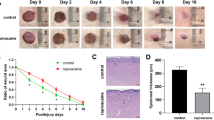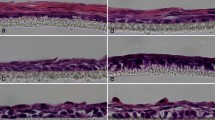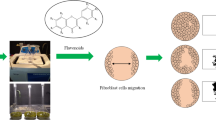Abstract
Local anaesthetics are known to affect a variety of cell functions, many of which are involved in the inflammatory response. Local anaesthetics have also been shown to influence cell proliferation. The aim of this study was to examine the effect of two local anaesthetics (ropivacaine and lidocaine) on cell proliferation of cultured human fibroblasts, vascular endothelial cells and epithelial cells, i.e. keratinocytes, as earlier studies have not included primary human cell types. Significant inhibition of fibroblast proliferation was observed with concentrations of 50 μM ropivacaine or 100 μM lidocaine in 1% newborn calf serum and 500 μM ropivacaine or lidocaine in 10% newborn calf serum. The proliferation of endothelial cells was significantly inhibited by 1 mM ropivacaine in 5% human serum and 500 μM ropivacaine or 100 μM lidocaine in 40% human serum. Significant inhibition was not obtained with lidocaine when these cells were cultured in 5% HS. Significant inhibition of keratinocytes was obtained with 100 μM ropivacaine and 500 μM lidocaine. The effective concentrations are within the range of therapeutical concentrationsin vivo and there seems to be a general correlation between the local anaesthetic potency and the inhibiting effect on cell proliferation. This suggest a mechanism by which local anaesthetics may exhibit anti-hyperproliferative effects in clinical situations.
Similar content being viewed by others
References
K. R. Courtney,Mechanism of frequency-dependent inhibition of sodium currents in frog myelinated nerve by the lidocaine derivative GEA 968. J. Pharmacol. Exp. Ther.195, 225–236 (1975).
G. Strichartz,Molecular mechanisms of nerve block by local anesthetics. Anesthesiology45, 421–441 (1976).
M. Chvapil, S. R. Hameroff, K. O'Dea and E. E. Peacock,Local anesthetics and wound healing. J. Surg. Res.27, 367–371 (1979).
R. Hammer, C. Dahlgren and O. Stendahl,Inhibition of human leukocyte metabolism and random motility by local anaesthesia. Acta Anaesthesiol. Scand.29, 520–523 (1985).
G. C. Moudgil, R. B. Allan, R. J. Russell and P. C. Wilkinson,Inhibition, by anesthetic agents, of human leucocyte locomotion towards chemical attractants. Br. J. Anaesth.49, 97–104 (1977).
R. Dickstein, L. Kiremidjian-Schumacher and G. Stotzky,Effects of lidocaine on the function of immunocompetent cells. I. In vitro exposure of mouse spleen lymphocytes and peritoneal macrophages. Immunopharmacology9, 117–125 (1985).
B. F. Cullen and R. H. Haschke,Local anesthetic inhibition of phagocytosis and metabolism of human leukocytes. Anesthesiology40, 142–146 (1974).
D. B. Giddon and J. Lindhe,In vivo quantitation of local anesthetic suppression of leukocyte adherence. Am. J. Pathology68, 327–338 (1972).
M. Rabinovitch and M. DeStefano,Cell to substrate adhesion and spreading: Inhibition by cationic anesthetics. J. Cell Physiol.85, 189–194 (1974).
R. R. MacGregor, R. E. Thorner and D. M. Wright,Lidocaine inhibits granulocyte adherence and prevents granulocyte delivery to inflammatory sites. Blood56, 203–209 (1980).
S. L. Peck, R. B. Johnston, Jr. and L. D. Horwitz,Reduced neutrophil superoxide anion release after prolonged infusions of lidocaine. J. Pharmacol. Exp. Ther.235, 418–422 (1985).
C. M. J. E. Vandenbroucke-Grauls, R. M. W. M. Thijssen, J. H. Marcelis, S. D. Sharma and J. Verhoef,Effects of lysosomotropic amines on human polymorphonuclear leucocyte function. Immunology51, 319–326 (1984).
K. Irita, I. Fujita, K. Takeshige, S. Minakami and J. Yoshitake,Cinchocaine and amethocaine inhibit activation and activity of superoxide production in human neutrophils. Br. J. Anaesth.58, 639–645 (1986).
M. B. Feinstein, J. Fiekers and C. Fraser,An analysis of the mechanism of local anesthetic inhibition of platelet aggregation and secretion. J. Pharmacol. Exp. Ther.197, 215–228 (1976).
T. Suzuki, K. Ohishi, J.-I. Kida and M. Uchida,Influence of pH on the inhibitory effects of local anesthetics on histamine release induced from rat mast cells by concanavalin A and compound 48/80. Eur. J. Pharmacol.98, 347–355 (1984).
C. Montecucco, S. Ballardin, G. P. Zaccolin and T. Pozzan,Effect of local anaesthetics on lymphocyte capping and energy metabolism. Biochem. Pharmacol.30, 2989–2992 (1981).
R. M. Ferguson, J. R. Schmidtke and R. L. Simmons,Inhibition of mitogen-induced lymphocyte transformation by local anesthetics. J Immunol.116, 627–634 (1976).
D. J. Cameron,Lidocaine inhibits macrophage mediated cytotoxicity and enhances neutrophil mediated cytotoxicity. Jap. J. Exp. Med.56, 265–269 (1986).
T. Huwyler, A. Hirt, D. Felix and A. Morell,Effect of cations and cation channel blockers on human natural killer cells. Int. J. Immunopharmacol.7, 573–576 (1985).
K. G. Chandy, T. E. DeCoursey, M. D. Cahalan and S. Gupta,Electroimmunology: The physiologic role of ion channels in the immune system. J. Immunol.135, 787s-791s (1985).
T. E. DeCoursey, K. G. Chandy, S. Gupta and M. D. Cahalan,Voltage-dependent ion channels in T-lyphocytes. J. Neuroimmunol.10, 71–95 (1985).
S. Björck, H. Ahlman and A. Dahlström,Topical treatment with lidocaine in patients with ulcerative proctitis/colitis. Ann. N.Y. Acad. Sci.594, 446–448 (1990).
S. Björck, A. Dahlström and H. Ahlman,Topical treatment of ulcerative proctitis with lidocaine. Scand. J. Gastroenterol.24, 1061–1072 (1989).
F. Shanahan and P. Anton,Neuroendocrine modulation of the immune system. Possible implications for inflammatory bowel disease. Dig. Dis. Sci.33, 41S-49S (1988).
P. Seeman,Electrical stabilization of the membrane by anesthetics and tranquilizers. Pharmacol. Rev.24, 584–587 (1972).
J. E. Sturrock and J. F. Nunn,Cytotoxic effects of procaine, lignocaine and bupivacaine. Br. J. Anaesth.51, 273–281 (1979).
L. Spångberg and B. Isaksson,Cytotoxic effect of Carbocain ® and Marcain ®.Acta Odontol. Scand. 28, 417–424 (1970).
S. H. Jackson and R. A. Epstein,The metabolic effects of nonvolatile anesthetics on mammalian hepatoma cells in vitro: I. Inhibition of cell replication. Anesthesiology34, 409–414 (1971).
S. H. Jackson,The metabolic effects of nonvolatile anesthetics on mammalian hepatoma cells in vitro: II. Inhibition of macromolecular precursor incorporation. Anesthesiology35, 268–273 (1971).
M. H. Gail and Ch. W. Boone,Procaine inhibition of fibroblast motility and proliferation. Exp. Cell Res.73, 252–255 (1972).
J. Bojta and F. Antoni,Effects of lidocaine on the membrane of human lymphocytes. Biochem. Pharmacol.28, 2441–2444 (1979).
G. V. Ramus, L. Cesano and A. Barbalonga,Different concentrations of local anaesthetics have different modes of actions on human lymphocytes. Agents and Actions13, 333–341 (1983).
P. J. M. Tutton and R. D. Helme,The influence of adrenoreceptor activity on crypt cell proliferation in the rat jejunum. Cell Tissue Kinet.7, 125–136 (1974).
G. L. Eastwood and J. S. Trier,Epithelial cell renewal in cultured rectal biopsis in ulcerative colitis. Gastroenterology64, 383–390 (1973).
B. Desaint, Cl. Legendre and Ch. Florent,Dysplasia and cancer in ulcerative colitis. Hepato-gastroenterol.36, 219–226 (1989).
R. G. Farmer,Cancer risk in ulcerative colitis. Scand. J. Gastroenterol. Suppl.170, 75–77, disc. 81–82 (1989).
I. H. Rosenberg and J. B. Mason,Folate, dysplasia and cancer: Editorial. Gastroenterology97, 502–503 (1989).
A. Haegerstrand, B. Jonzon, C.-J. Dalsgaard and J. Nilsson,Vasoactive intestinal polypeptide stimulates cell proliferation and adenylate cyclase activity of cultured human keratinocytes. Proc. Natl. Acad. Sci. USA86, 5993–5996 (1989).
A. Couvineau and M. Laburthe,The human vasoactive intestinal peptide receptor: Molecular identification by covalent cross-linking in colonic epithelium. J. Clin. Endocrinol. Metab.61, 50–55 (1985).
D. P. Chopra, K. M. Siddiqui and R. A. Cooney,Effects of insulin, transferrin, cholera toxin and epidermal growth factor on growth and morphology of human fetal normal colon epithelial cells. Gastroenterology92, 891–904 (1987).
R. I. Freshney, Culture of Animal Cells — A Manual of Basic Technique. pp. 113–115. Alan R. Liss, Inc., New York, 1987.
A. Haegerstrand, C. Gillis and L. Bengtsson,Serial cultivation of adult human endothelium from the great saphenous vein. J. Vasc. Surg.16, 280–285 (1992).
H. Green, O. Kehinde and J. Thomas,Growth of cultured human epidermal cells into multiple epithelia suitable for grafting. Proc. Natl. Acad. Sci. USA76, 5665–5668 (1979).
E. Pigeolet, M. Raes, A. Houbion and J. Remacle,Effect of procaine on cultivated human WI-38 fibroblasts. Exp. Ger.23, 87–96 (1988).
J. A. W. Wildsmith, D. T. Brown, D. Paul and S. Johnson,Structure-activity relationships in differential nerve block at high and low frequency stimulation. Br. J. Anaesth.63, 444–452 (1989).
C. D. Cone Jr.,Electroosmotic interactions accompanying mitosis initiation in sarcoma cells in vitro. Trans. N.Y. Acad. Sci.31, 404–427 (1969).
C. D. Cone Jr. and M. Tongier Jr.,Control of somatic cell mitosis by simulated changes in the transmembrane potential level. Oncology25, 168–182 (1971).
C. D. Cone Jr.,Maintenance of mitotic homeostasis in somatic cell populations. J. Theor. Biol.30, 183–194 (1971).
G. L. Nicolson, J. R. Smith and G. Poste,Effects of local anesthetics on cell morphology and membrane-associated cytoskeletal organization in BALB/3T3 cells. J. Cell. Biol.68, 395–402 (1976).
C. J. Dinsdale, F. M. Mirza and J. P. Wiebe,Glycerol alters cytoskeleton and cell adhesion while inhibiting cell proliferation. Cell. Biol. Int. Rep.16, 591–602 (1992).
R. J. Leonard, M. L. Garcia, R. S. Slaughter and J. P. Reuben,Selective blockers of voltage-gated K+ channels depolarize human T lymphocytes: Mechanism of the antiproliferative effect of charybdotoxin. Proc. Natl. Acad. Sci. USA89, 10094–10098 (1992).
Author information
Authors and Affiliations
Rights and permissions
About this article
Cite this article
Martinsson, T., Haegerstrand, A. & Dalsgaard, CJ. Ropivacaine and lidocaine inhibit proliferation of non-transformed cultured adult human fibroblasts, endothelial cells and keratinocytes. Agents and Actions 40, 78–85 (1993). https://doi.org/10.1007/BF01976755
Received:
Accepted:
Issue Date:
DOI: https://doi.org/10.1007/BF01976755




